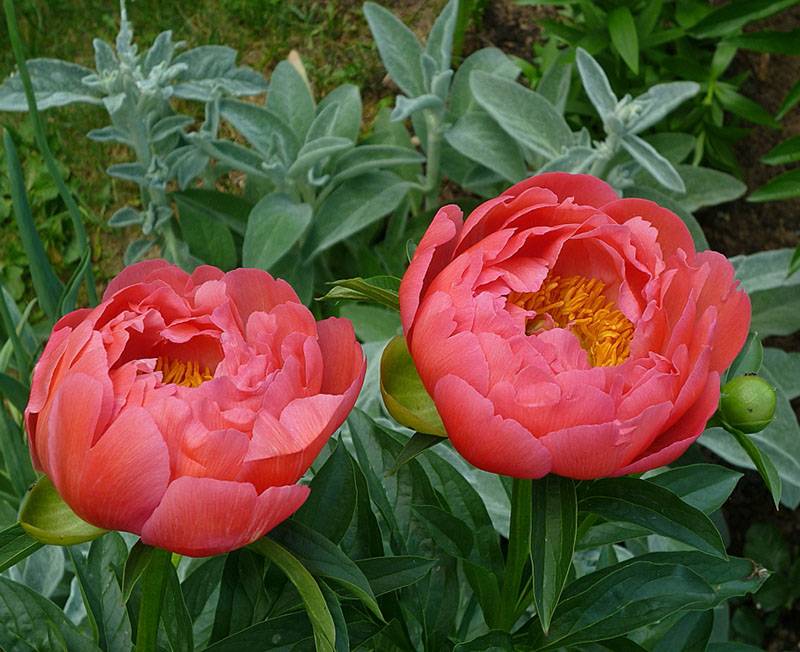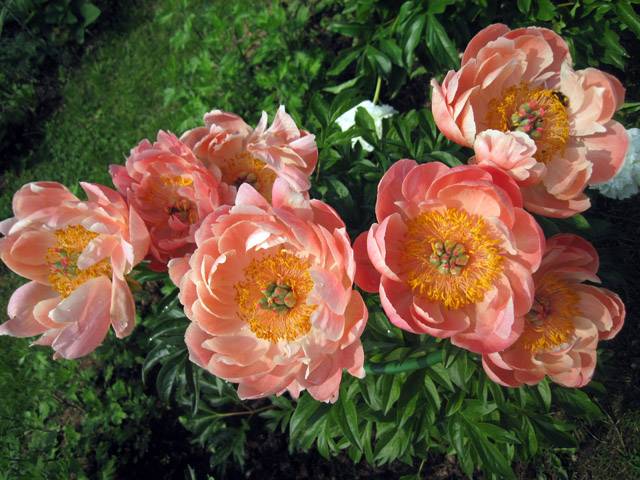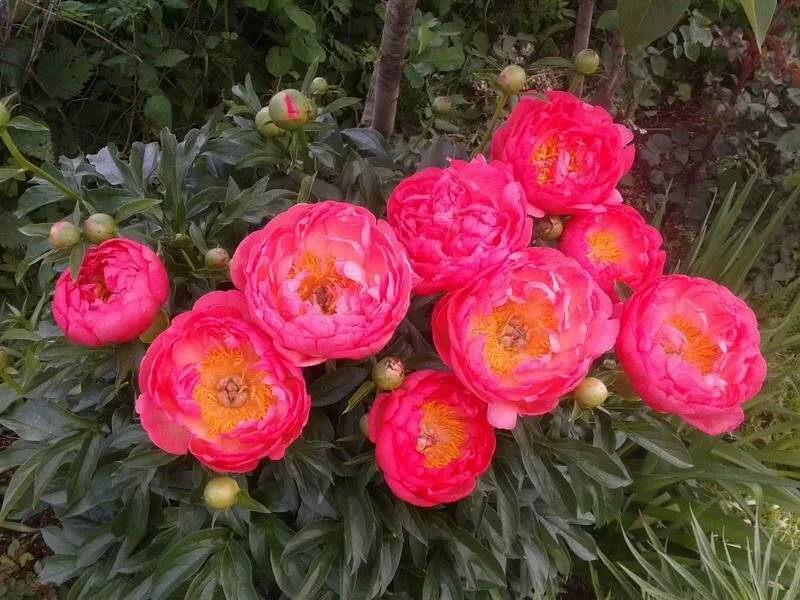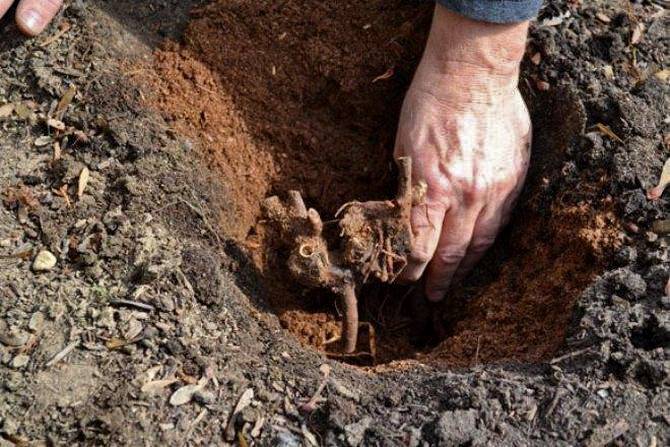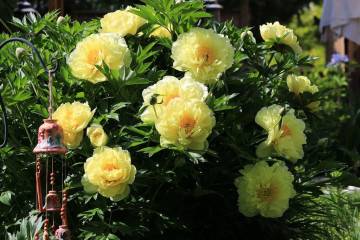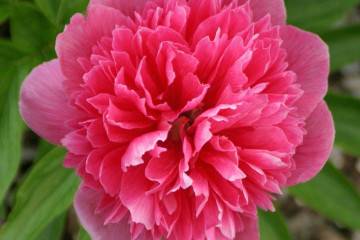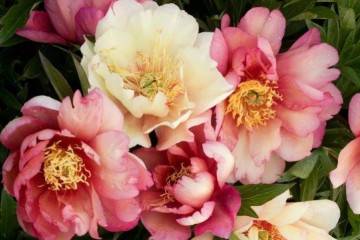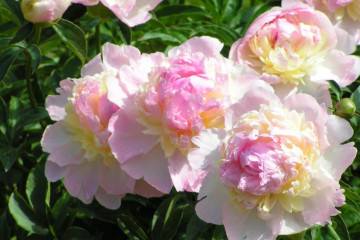Peony Coral Sunset (Paeonia Coral Sunset)
Content:
Peony Coral Sunset belongs to the modern group of ITO peonies, which are gaining more and more popularity. During the flowering period, it is a unique, unrepeatable sight. Even those growers who are not considered peony lovers are eager to get this beautiful flower to grow in their garden.
Peony Coral Sunset (Paeonia Coral Sunset) - what is this variety
Paeonia Coral Sunset is the brainchild of the famous breeder S. Wissing. It took about 20 years to remove the flower, but the result was worth the time. Peony Coral Sunset is a hybrid of the milky-flowered herb variety Cardin and the tree-like Kinko peony with yellow buds. This is typical for all ITO pions.
Brief description and characteristics
Botanical description of the Coral Sunset peony:
- herbaceous perennial, a representative of the Peony family;
- has signs of both tree and herbaceous hybrids;
- shoots are high, up to 1 m, dense, erect green;
- leaves are narrow, long, bright green, they are densely located on the stem;
- the root system is fibrous, lignified, growing to the sides over time;
- the flower is large, up to 20 cm in diameter, semi-double;
- petals of a bright salmon color, which is clearly expressed in the core, and gradually brightens towards the edges;
- the smell is practically absent.
Several buds gradually bloom on one stem, but the largest of them is the first, the next are significantly inferior to it in size.
Advantages and disadvantages of the variety
| Advantages of the variety | Disadvantages of the variety |
| high decorativeness | high price |
| immunity to disease | short flowering |
| suitable for cutting | weak aroma |
| tolerate temperature changes well | |
| frost resistance |
Use in landscape design
The bushes of this variety of peonies look great as single plants, since they hold the branches well, they do not bend even under the weight of heavy flowers and do not fall apart. This quality was passed on to the flower by inheritance from tree-like peonies. In addition, the bush retains a high decorative effect right up to the very frost, even after flowering.
With the onset of autumn coolness, the leaves turn purple and continue to decorate the garden. As soon as the first light frosts set in, the stems are covered with light frost, which brings a new, decorative touch to the general background of withering nature. In group compositions, the flower can also look very impressive, often becoming the center of them.
Growing a flower: how to plant it in open ground
The agrotechnics of the plant is similar to the agrotechnics of other peonies of the herbaceous group.
Planting by root cuttings
Root cuttings can be removed from the mature plant at the end of the flowering period. The optimal time is mid-August. This procedure is carried out as follows:
- The rhizome of an adult peony is removed from the ground, excess soil is gently shaken off from it and damaged and rotten roots are removed.
- The rhizome is divided into a maximum number of small parts of 1-3 cm, each of which must have 1 root and 1 root bud.
- Cuttings are soaked for 1 hour in a solution of potassium permanganate or disinfectant.
- Then the pieces of rhizome are rolled in crushed charcoal and left overnight until a small crust is formed.
- Cuttings are planted in loose nutrient soil at a distance of 20 cm from each other.
In the future, caring for future plants consists in covering in hot weather, timely watering, weeding.
What time is the boarding
The optimal time for planting this variety of peonies is spring (when the soil warms up sufficiently), late summer or early autumn. The geographical position of the site in which it is planned to grow the flower will help to choose summer or autumn. In the Central, Central lane or in the south of Russia, autumn planting is preferable. But residents of colder regions, in contrast to warmer places, should take care of the August planting of the plant.
Seat selection
ITO-hybrid peonies grow better on fertile loamy soils. The plant will not like peat soils, since such soil will be too acidic for it. The landing site should be free of drafts, protected from gusts of wind. You can not choose very sunny areas, but you can not plant in the shade either.
How to prepare the soil and flower for planting
A month before planting, a hole is dug, the soil is well dug, expanded clay or crushed stone, humus, coarse river sand and compost are introduced into it. You can also add mineral complex fertilizers for flowering garden plants.
The root system of the seedling should be inspected for damage and dried roots. Too long should be shortened. You can briefly hold the bush in the root, epine or other similar means. No additional processing is required before planting.
Planting procedure step by step
Planting Coral Sunset peonies step by step:
- A landing pit 60 × 60 × 80 cm is being prepared.
- The holes are filled with a mixture of sand, gravel, compost, humus. Potash fertilizers and ash can be added as additional dressings.
- The pit is filled with prepared soil mixture and left for about a month so that the earth is well compacted.
- After this time, peonies are not planted too deeply in the hole.
- The soil is compacted and thoroughly watered.
Seed planting
Planting with seeds is not recommended as the daughter plant will not inherit all the features of the mother bush. It will be beautiful, interesting, but already a different view. Moreover, Coral Sunset is a popular variety, so it is quite easy to purchase its seedlings.
Plant care
This peony does not impose too high demands on care, but like any other decorative flowering plant, it needs timely watering, proper feeding, loosening the soil and treatment from possible fungal diseases and parasitic insects.
Watering and feeding
Watering should be carried out quite often, only with warm, settled soft water. Its amount should not be too large, since flowers do not like overflow. The first feeding with complex mineral fertilizers is carried out in the spring at the very beginning of the growing season.In total, during the season, you should not feed the plant more than 3 times.
Mulching and loosening
After each watering, it is recommended to spud the flower, it will have a beneficial effect on the internal and external state of the plant. Mulching with natural materials is also useful, which will reduce the evaporation of liquid from the soil surface.
Preventive treatment
Despite the fact that ITO peonies have a fairly high immunity, in the spring they can be sprayed with insecticides in order to prevent the appearance of pests. Treatment with fungicides will help prevent the appearance of diseases. It is also important before winter, after the pruning procedure, to loosen the soil, clean it of dry leaves and burn them.
Peony Blossom Coral Sunset
The blooming period of the Coral Sunset peony is the most anticipated event for all growers. After all, it is at this time that all the brightness, showiness, beauty of the plant are visible.
A period of activity and rest
This variety is characterized by a medium to late flowering period. It blooms in late May, the last flowers wither in late June - early July. For the first time, a peony blooms a year after planting.
Care during and after flowering
During flowering, the most important thing is to remove wilted buds in time.
What to do if it does not bloom
If the plant is not flowering, it may have been planted incorrectly, such as in the shade or with high flowing groundwater. It is also possible that it is not protected from drafts. In this case, a peony should be transplanted. If it doesn't bloom in the first year after planting, there is nothing to worry about, this is normal.
Peonies after flowering
After flowering, peonies retain high decorative qualities and delight the eye throughout the season, right up to the frost. Their bushes are very lush, rich green, there are a lot of leaves on the stems. Therefore, such a peony looks great.
Transfer
Transplanting a peony to a new place is performed only as needed. This procedure is combined with the division of the rhizome and is rejuvenating.
Pruning
Coral Sunset peonies are pruned in the fall. The stems and leaves are completely removed. The slices are sprinkled with crushed charcoal.
Preparing for winter
Since the variety is very frost-resistant and can withstand temperatures down to -40 ° C, it does not need shelter. A stable snow cover will be enough for him.
Diseases, pests and ways to control them
Peony, as a rule, is resistant to diseases, but some insects do not bypass it. This is most often:
- aphid;
- shield;
- whitefly;
- ants (especially where there are aphids).
The fight against them is possible with the help of special preparations.
It is no coincidence that the unusual and bright peony Coral Sunset is recognized as one of the best representatives of the ITO-peonies group. It will become a decoration of any flower bed, any suburban area. This plant will not leave anyone indifferent.
